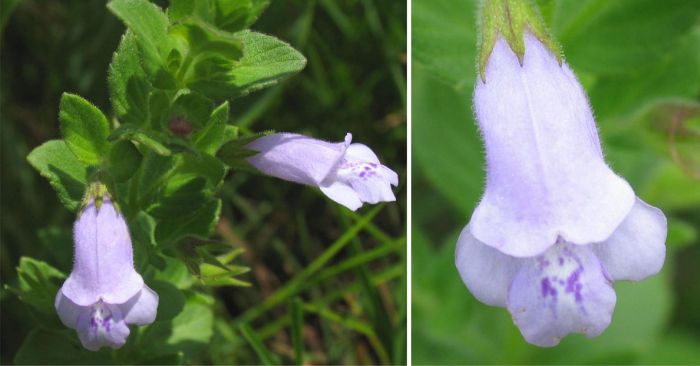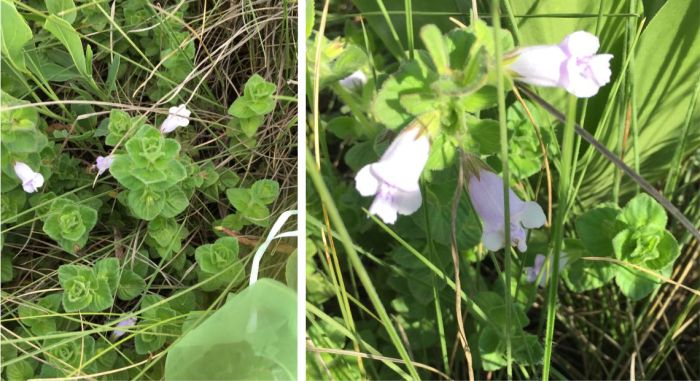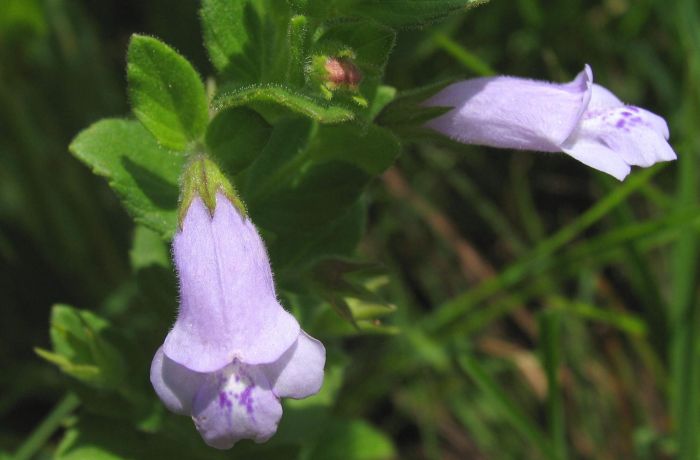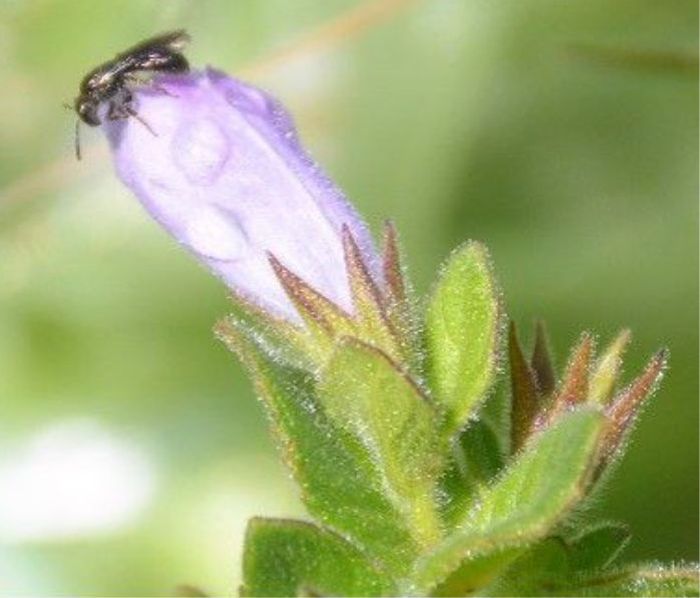Killickia grandiflora
Killickia grandiflora (Killick) Bräuchler, Heubl & Doroszenko
Family: Lamiaceae
Common names: Cathedral Peak killickia
Introduction
The relatively unknown small genus, Killickia, consists of four species: three are endemic to the Drakensberg Mountain Centre and the fourth species has a more widespread distribution that extends to the KwaZulu-Natal Midlands. Killickia grandiflora is a rare species, restricted to the catchment areas of the Cathedral Peak Management Unit (CPMU) of the uKhahlamba Drakensberg Park World Heritage Site.

Description
Description
Perennial, slightly decumbent herb, with its shoots growing up to c. 400 mm in height. Killickia grandiflora is distinguished from the other three Killickia species by its larger, light cobalt-violet corolla, 20–24 mm long, ovate cordate bracteoles that resemble the leaves, calyx teeth 3.0–5.0 mm long, and the straight lower lip of the corolla, although its tip and edges curve downwards, whereas the other species have smaller (cobalt-coloured or not) flowers, and linear bracteoles and calyx teeth that less than 2.0 mm in size. The leaves of K. grandiflora are aromatic, with a strong mint-like smell when bruised. Flowering time is in midsummer, between November and February.

Conservation Status
Status
Although Killickia grandiflora grows in a protected area, its persistence is threatened by irregular burning. This species is locally extinct in its type locality, Catchment 9 in Cathedral Peak Management Unit (CPMU), following the removal of fire as a formal management tool to make it a fire exclusion catchment. Pteridium aquilinum L. (bracken fern) now dominates this site and is also threatening another known population. Killickia grandiflora has been assessed as Vulnerable (VU) on the Red List of South African Plants.

Distribution and habitat
Distribution description
Killickia grandiflora is a rare species, endemic to the Drakensberg Mountain Centre. To date, all the collections of this species trace back to three catchment areas, in the temperate grasslands of the protected CPMU. It grows on moist basalt-derived soils in full sunlight in Themeda triandra grassland at an altitude of c. 1830–2040 m above sea level.
Derivation of name and historical aspects
History
Killickia grandiflora was collected for the first time in November 1950 by Donald Killick, where he described the species as a ‘locally frequent decumbent herb, mauve, leaves pungent when bruised’ and placed it in the genus Micromeria. In 2008, Bräuchler described the genus Killickia to accommodate the endemic species formerly placed in Micromeria and named it in honour of Dr. Donald Killick (1926–2008), who carried out botanical inventories throughout the Drakensberg Mountains and contributed enormously to our knowledge of the Killickia species. Killickia grandiflora, as the name suggests, has the largest flowers of all the Killickia species.

Ecology
Ecology
Killickia grandiflora has underground runners, suggesting it may rely primarily on vegetative reproduction, which might explain why it forms such localised aggregations. However, potential pollinators were observed frequenting the flowers (Kgaboesele 2019), which suggests that it may be reproducing sexually but have limited dispersal ability.

Uses
Use
It is not known whether the plants can be used medicinally, but other members of the family Lamiaceae are well known for their culinary and medicinal uses. For example, the famous culinary herb, Ocimum basilicum (basil) has been used medicinally as an immune-stimulatory, antiviral and antioxidant (Charvat et al., 2006). Mentha longifolia (wild mint), also in the Lamiaceae, is frequently used to treat respiratory ailments and it is also used as a herb in numerous cuisines. Lamiaceae is one of the most important medicinal and culinary herb plant families and the potential of K. grandiflora is unknown and uninvestigated. Some Lamiaceae species even have potential use for future in isolation of potentially active compounds for formulation of commercial therapeutic agents (Uritu et al., 2018).
Growing Killickia grandiflora
Grow
To date, no success has been achieved with seed propagation under growth room conditions (Kgaboesele, 2019). This study however had a small sample size of 13 mature seeds, which make the results unreliable. It could also be that K. grandiflora seeds, like some members of the Lamiaceae, exhibit physiological dormancy and require some form of seed pre-treatment. For example, dormancy in the seeds of Prostanthera species (Lamiaceae) was overcome by subjecting them to different treatments such as the removal of the mericap plugs (Ainsley and Jones, 2010).
References
- Adcock, K. 1990. Vegetation changes since withdrawal of fire from Catchment IX, Cathedral Peak, Natal Drakensberg. MSc dissertation, University of the Witwatersrand, Johannesburg.
- Ainsley, P.J. & Jones, M.K. 2010. Overcoming physiological seed dormancy in semi-arid Prostanthera (Labiatae). Journal of the Adelaide Botanic Gardens, 24: 1-5.
- Bräuchler, C., Doroszenko, A., Esser, H.J. & Heubl, G. 2008. Killickia (Lamiaceae): a new genus from KwaZulu-Natal, South Africa. Botanical Journal of the Linnean Society,. 157: 507 575–586.
- Carbutt, C. 2019. The Drakensberg Mountain Centre: A necessary revision of southern Africa’s high-elevation centre of plant endemism. South African Journal of Botany 124: 508–529. https://doi.org/10.1016/j.sajb.2019.05.032.
- Carbutt, C. & Bräuchler, C. 2012. The rediscovery of Killickia grandiflora (Lamiaceae), a narrow endemic from the northern KwaZulu-Natal Drakensberg. Plant Life 41:40–45.
- Charvat, T.T., Lee, D.J., Robinson, W.E. & Chamberlin, A.R. 2006. Design, synthesis, and biological evaluation of chicoric acid analogs as inhibitors of HIV-1 integrase. Bioorganic & medicinal chemistry, 14(13), pp.4552-4567.
- Granger, J.E. 1976. The vegetation changes: some related factors and changes in the water balance following 20 years of fire exclusion in catchment IX: Cathedral Peak Forestry Research Station. PhD thesis, University of Natal, Pietermaritzburg.
- Kgaboesele, P.L. 2019. Ecological speciation and breeding systems in the Drakensberg Mountain Centre near-endemic genus, Killickia (Lamiaceae). Unpublished MSc. Thesis, University of the Witwatersrand, Johannesburg.
- Uritu, C.M., et al. 2018. Medicinal plants of the family Lamiaceae in pain therapy: A review. Pain Research and Management.
- von Staden, L. 2019. Killickia grandiflora (Killick) Bräuchler, Heubl & Doroszenko. National Assessment: Red List of South African Plants version 2020.1. Accessed on 2021/02/01
Credits
Portia Kgaboesele
National Herbarium (PRE)
March 2021
Acknowledgements: the author thanks Janine Victor for help and advice with this article, and Clinton Carbutt for his input and allowing the use of his photos of Killickia grandiflora, as credited.
Plant Attributes:
Plant Type: Perennial
SA Distribution: KwaZulu-Natal
Soil type: Clay, Loam
Flowering season: Early Summer, Late Summer
PH:
Flower colour: Purple, Mauve/Lilac
Aspect: Full Sun
Gardening skill: Challenging
Special Features:
Horticultural zones







Rate this article
Article well written and informative
Rate this plant
Is this an interesting plant?
Login to add your Comment
Back to topNot registered yet? Click here to register.